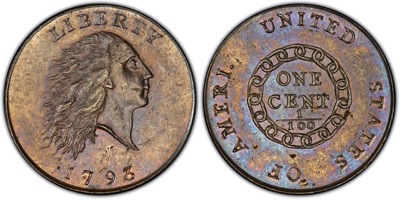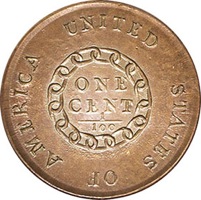It's a story of copper, hair and slavery. The chain cent (also known as the flowing hair cent) was the first cent minted in 1793. The mint law of 1792 stated that the obverse should depict a device emblematic of liberty. The interpretation of liberty and freedom was hair that was free to blow in the wind. The mint hired Henry Voight, a watch maker, to design the cent. As a result, Miss Liberty was as homely as a mud fence and had a hairstyle that looked like she had been holding Ben Franklin's kite. The coin was unloved by the people, who felt the obverse portrait was more a symbol of savagery or madness.
The reverse of the coin depicted a chain surrounding the words “One Cent” and the fraction “1/100.” The fraction was included because many American who were illiterate understood fractions (unlike today when many Americans are literate, but have difficulty with fractions). The chain was designed as a symbol of unity. Many citizens, however, saw it as an objectionable symbol of slavery.
The 1793 cent was not the first coin with a chain. The 1776 Continental dollar depicted thirteen linked rings, each bearing the name of a colony. In 1787, the fugio cent had thirteen unlabeled links, whose meaning was clarified with the slogan “We are One” printed in the center of the ring of chains. For the 1793 cent, the chain simply looked like a chain. The antislavery movement had grown significantly between 1776 and the 1790’s. The constitution prohibited changes in regulations to the slave trade until 1808, presumably to allow states more time to settle differences. The constitution allowed the import of slaves (Article 1 section 9) and prohibited citiziens in assisting escaped slaves (Article 4 section 2).
In 1787, Benjamin Franklin became the president of the Pennsylvania Society for Promoting the Abolition of Slavery and began to publish essays urging abolition. In 1790, the quakers started a “free produce” movement which boycotted products produced with slave labor. The chain was no longer a politically acceptable symbol for unity.
On one variety of the chain cent, the reverse stated "United States of Ameri. " The abbreviation sure didn't save much.

Collecting chain cents
In 1793, only 36,103 chain cents were produced. It is estimated that only about 1500 have survived. Many of the survivors are well worn and have rough surfaces. Since the chain cent is a single year type coin, it is in high demand. Even in poor condition, where the coin is virtually worn smooth, a chain cent can still sell for over $1000. In January, 2011, Heritage auctions sold a chain cent for a 1.38 million dollars, a record for a copper coin. After only a few months production, the chain cent was quickly abandoned. Liberty's hair was brushed slightly in a futile attempt to make her more attractive. The chain was replaced by a wreath. The citizens were still dissatisfied.
Please go to the large cent page to see other designs.

